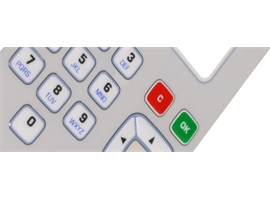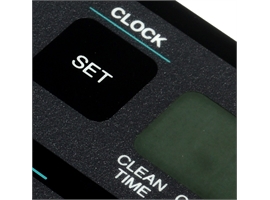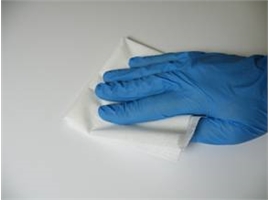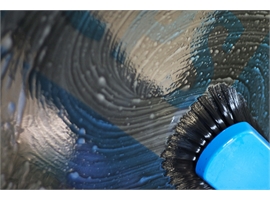Download Print Friendly Version: English Russian
How To Guide - Printing Texturing Lacquers
Synopsis...
How to Guide
This simple How to Guide will show you the best way to print high quality surface textures using Fototex N and Fototex UV texturing lacquers onto the range of Autoflex hard surface coated polyester and polycarbonate films from MacDermid Autotype. Refer to individual product data sheets for substrate compatibility.
Objective – To reliably print, high quality, consistent textured finishes onto Autoflex films which have excellent adhesion and scratch resistance, well defined edges, uniform thickness and no contamination.
Recommendations
Frames - It is critical that the mesh releases from the ink film immediately after the squeegee passes, so high tension stretching (> 20N/cm) onto a rigid metal frame is required. Autotype 2-Part Screen Adhesive will hold the high mesh tensions that are required and will not slip when exposed to Autosolve cleaning solvents.
Mesh - Always use the highest quality polyester mesh for Fototex printing, as even minor variations in weave quality can show up in the print. Select a 90 threads/cm monofilament PET mesh for Fototex UV printing and 100–150 threads/cm for Fototex N. The use of a finer mesh can give rise to variations in gloss levels as the matting agents in the Fototex lacquer are filtered out by the fine mesh. Conversely, if too coarse a mesh is used this will lead to a thick print that may not cure fully.
The mesh must be totally clean and free from all ghost images before the stencil is made. Always use Universal Mesh Prep or Auto Degreaser Concentrate to ensure the best stencil adhesion possible and use Autokleen Plus to remove any mesh staining if the screen has been used before.
Stencils – Fototex prints are typically block images, so stencil resolution is not critical, however to create a cleanly defined edge a high quality stencil such as Capillex 35 is perfect. The high EOM and low Rz of the Capillex 35 stencil will ensure good edge definition. If a lower print shoulder is required, select Capillex 25, or for less critical applications, use PLUS 1-SR or PLUS 7000 photostencil emulsions.
Printing – In order to get the best adhesion of the Fototex lacquer to Autoflex, the sheets must be printed within 48 hours (ideally within 24 hrs) after removing them from the original packaging. N.B Autoflex PC MUST be printed with Fototex within 24 hours. If Autoflex is left unwrapped, the surface will slowly react with air and light which reduces the adhesion between Fototex and the hard coat surface. Therefore, the Fototex texture must always be printed first, or second in the print sequence. Once correctly cured, the adhesion of the Fototex lacquer is permanent and will not deteriorate.
IMPORTANT: Only handle Fototex lacquer in a UV-free environment and it is critical to thoroughly stir Fototex for a minimum of 2 minutes prior to printing.
Print using a very high quality 70-90 shore Polyurethane squeegee, as even the smallest nick in the squeegee blade will show up in the print. It is also recommended to set both the squeegee and flood stroke start/stop positions at least 20cms beyond the image area to allow the lacquer to settle before reaching the critical print area.
The recommended texture thickness is 20–25µ for Fototex N and 30-40µ for Fototex UV products. Always use a micrometer to accurately measure the texture thickness.
How to minimise dust contamination
Dust is impossible to remove from the cured Fototex print, therefore prevention is always better than contamination!
- A clean working environment is essential for printing quality textured finishes
- Remove any contamination from the dry screen prior to printing with a low tack roller
- If the print room is not a ‘clean room’, then create a cleaner environment around the press by curtaining. This will also enable you to increase the relative humidity (RH) to reduce static build up during printing. An extractor hood will be required for local exhaust
- The operators should wear clean room clothing
- Always clean the substrate prior to printing using a low tack roller or machine
- Try to restrict personnel movement in the area during printing
- Place tack mats around the press
- Cover the screen during stoppages or remove the lacquer
- Never return unused lacquer to the pot
Curing - Fototex UV can be cured on most conventional high intensity UV curing units. A curing dose of 500–1,000 mj/cm² is required.
Fototex N requires UV curing in a Nitrogen blanket such as the Linde system.
Cleaning - press wash: If the screen needs to be cleaned during printing, use Autosolve Press Wash AF and allow the mesh to dry out completely before recommencing printing.
Cleaning - archiving: If the screen is to be archived for reuse, the screen can be cleaned with either Autosolve Press Wash AF40 or Autosolve Press Wash AF55 as these solvents do not contain emulsifying agents which could leave a residue.
Cleaning - decoating: If the stencil is to be decoated, use Autosolve Industrial AF which is a water washable screen cleaning solvent.
Stencil removal - Ghost images in the mesh can cause shadow marks in the print, therefore to get the best results use Autostrip stencil stripper followed by Autokleen Plus, low caustic haze remover.
Our range of products for printing perfect textures
|
Texturing lacquers |
|
|
Hard coated films |
|
|
Mesh adhesive |
|
|
Mesh degreasers |
|
|
Photostencil films |
|
|
Photostencil emulsions |
|
|
Press wash solvents |
|
|
Screen wash solvent |
|
|
Stencil stripper |
|
|
Haze remover |








